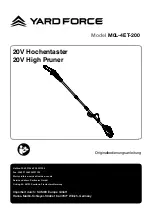
25
25
Blade Selection
Refer to Figures 29 and 30.
The following information is general in nature. The
scroller is encouraged to research specific options to
meet project needs. Note that the same specifications
may vary among manufacturers.
A wide array of blades are available for the scroll saw.
Woodworking blade sizes range from #3/0 to #12.
Here are factors to consider when selecting a blade:
•
Type of material to be cut (hardwood, softwood?).
•
Thickness of workpiece (thicker pieces will require
larger blades).
•
Features of workpiece (straight cuts, sweeping
curves or tight fretwork?).
These factors are important because they involve
basic concepts of blade design. There are 5 blade
features that normally vary to meet certain kinds of
sawing requirements. They are:
1. width
2. pitch (number of teeth per inch)
3. tooth set
4. blade material
5. tooth form
Width
Width is measured from back edge of blade to tip of
tooth. Generally, wider blades are used for making
straight cuts and long curves. Narrow blades are
suited for cuts with tight corners, such as fretwork.
When cutting straight lines with a narrow blade, the
blade may have a tendency to drift (called “blade
lead”).
Pitch
Pitch is measured in “teeth per inch” (TPI) and can be
constant or variable.
A fine pitch (more teeth per inch) will cut slowly but
more smoothly and minimize vibration. A coarse pitch
(fewer teeth per inch) will cut faster but more roughly.
Try to use a blade that will have a minimum of 3 teeth
engaged in the workpiece at any given time.
Set
“Set” refers to the manner in which the blade teeth are
bent or positioned. Bending the teeth creates a kerf
that is wider than the back of the blade. This helps the
operator more easily pivot a workpiece through curve
cuts, and decreases friction between blade and
workpiece on straight cuts. Two common sets are the
straight (or alternating) and the raker.
Figure 29: Blade Anatomy
Material
Blades are manufactured by stamping, milling, or
grinding.
•
Stamped blades
are punched out on a press from
sheet steel. The teeth are given an alternate set to
allow clearance in the kerf.
•
Milled blades
are made by flattening a steel wire,
cutting the teeth through a “milling” process, then
heat-hardening the steel.
•
Ground blades
have high-carbon steel teeth
which tend to hold their sharpness longer and
provide smooth cuts.
Special styles
are also available, such as twist and
spiral blades, which cut from all sides.
Most blades offered are 5 inches long; if a longer blade
is acquired the end can be snipped off to
accommodate the saw.
Optimally, a blade (and the operator’s technique)
should leave smooth, clean cuts that do not require
sanding, as it is often very difficult to sand inside cuts
after they are made.
















































